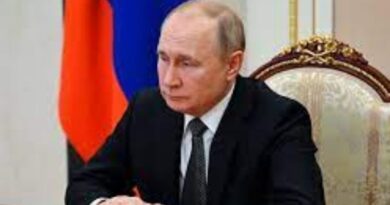Evidences of historians prove that the battle of Haldighati was not won by Akbar but by Maharana Pratap.
A few days ago it was reported that the most famous battle of Haldighati in the medieval history of Rajasthan was not won by the Mughal emperor Akbar but by Maharana Pratap.
It has been thoroughly researched, in which it has come to the fore that Akbar lost the battle of Haldighati, Maharana Pratap won the war with his excellent fighting skills.

1. Historian claims –
Now let us tell you that this issue was written by historian Dr. A book written by Chandrashekhar Sharma named ‘Rashtra Ratan Maharana Pratap’ has been raised on the basis of the researches written.
This book was published in 2007. This book was published by Aryavrat Sanskriti Sansthan of Delhi. Historian Dr. Chandrashekhar Sharma with his research and evidence has described Maharana Pratap as the winner of this war.
2. Who is the author?
Dr. Chandrashekhar Sharma, author of ‘Rashtra Ratan Maharana Pratap’, who teaches the students of Meera Kanya Mahavidyalaya, a government college in Udaipur.
And he has worked on this book for his PhD from Janardan Rai Nagar Rajasthan Vidyapeeth University in the city.
Read more – Here are the reasons why Dr. Sharma considers Maharana Pratap to be the winner:
3. Pratap had fulfilled his objectives by –
Completely ‘on purpose’ Sharma says that Pratap defeated Akbar.
Pratap’s main objective was to protect his native land.
If Akbar had won the war, he would have arrested Pratap and sentenced him to death and captured his kingdom. There is evidence that Akbar could not succeed in his plans.
4. What happened after the war –
After the battle of Haldighati, Akbar was angry about the defeat with the generals Man Singh and Asif Khan and for this reason both of them were punished for not coming to the court for six months.
Had the Mughal army won, Akbar would have rewarded those who defeated his greatest adversary, Pratap, but this did not happen.
From this it is clear that Maharana Pratap won the battle of Haldighati.
5. Pattas issued in the form of copper plates of lands –
In his research, Dr. Sharma has submitted the evidence related to the copper letters showing Pratap’s victory in Janardan Rai Nagar Rajasthan Vidyapeeth University.
Sharma says that according to him, for the next one year after the war, Maharana Pratap issued the pattas of the lands of the villages around Haldighati in the form of copper plates.
6. signature of Maharana Pratap –
These were signed by Pratap, the Diwan of Eklingnath.
At that time only the king had the right to issue land leases. Had Pratap not won, he could not have signed those copper plates.
7. Included in the book –
Sharma has also published these copper letters in his book by collecting them from the then great Rajput families and farmers of the villages.
With this, he concluded that there was no tampering with Pratap’s administrative system only after the battle of Haldi Ghati.
8. Control of Maharana Pratap over Bhilwara and Mewar region –
They say that traces of Pratap’s effective control over the Bhilwara plains as well as the important hill areas of Mewar are still present. In 1834, the land on which the tomb of Maharana Pratap’s horse Chetak was renovated,
In fact, that land was allotted by Pratap only after the Battle of Haldighati in 1576 to build the samadhi.
It is clear from this that even after the battle of Haldighati, Maharana Pratap had control over Mewar and its surrounding areas.
9. Pratap’s Guerrilla War –
Maharana Pratap was the first such Indian king.
who also fought guerrilla warfare and used this tactic in a very systematic way.
As a result, the Mughals were forced to kneel. There was a time when almost the whole of Rajasthan was under the possession of the Mughal emperor Akbar, but Maharana fought with Akbar for 12 years to save his Mewar.
10. Pratap remained victorious –
Akbar adopted every trick to defeat him, but Maharana remained undefeated till the end. Along with this, Sharma says that this technique of warfare is neither state governed nor time bound.
People believe that this war lasted only for four hours, but this is not true. Whereas this fight lasted from sunrise to sunset.
11. Two Chapters of War –
Apart from archaeological evidence, it has also been cited in literary works of Indian and Persian origin. The first chapter of this war started in Haldi Ghati after Pratap attacked the Mughals.
Where he forced the Mughals to flee. Whereas the second chapter took place in Raktalai, about 7 kilometers from Haldighati.
12. What is the opinion of the local people –
Sharma says that he considers himself a proud Rajasthani and loves the folktales praising the courage and pride of Maharana Pratap there.
He tells that the local people have always believed that their king Pratap had defeated Akbar, it does not matter to them what is written in Thas and what is not.
In his eyes, Pratap is his hero.
This is absolutely true.
13. Akbar got only one elephant –
It is said that in this historical war, Akbar was the only precious elephant, whose name was Ram Prasad.
But he was able to establish his dominance. And at that time Akbar’s army was on that elephant. She was beating from village to village that she had defeated Pratap. But no one believed him.
14. Contribution of copper plates –
Through these folk tales, these people make fun of Akbar that he has made up his victory story with lies. But at the same time, Sharma said that he is not trying to promote any kind of ideology. ‘I did my research without any hypothesis,’ he says, ‘Copper letters’ have contributed a l




